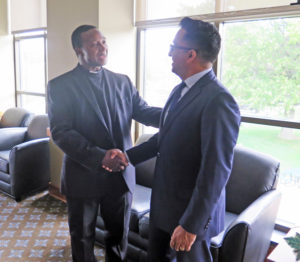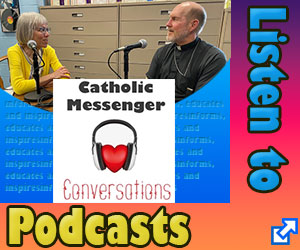By Anne Marie Amacher
The Catholic Messenger
DAVENPORT — While giving a presentation on euthanasia and physician-assisted suicide, Dr. Ashley Fernandes shared the following quote from the Irish bishops’ 1975 statement: “It is often said nowadays that we should not consider so much the mere existence of life, but rather the quality which that life has the prospect of attaining. … This argument turns moral principles upside down. … Life has the right to quality and dignity because it exists. Life does not derive the right to exist from the quality which circumstances seem likely to give it.”

Father Fortunatus Rwehikiza, left, a priest from Tanzania, Africa, studying at St. Ambrose University in Davenport, thanks Dr. Ashley Fernandes following a talk on euthanasia and physician-assisted suicide Oct. 13 in Davenport.
“This is why I love the Catholic Church,” said Dr. Fernandes, an associate professor of pediatrics at Nationwide Children’s Hospital in Columbus, Ohio, and the associate director of Ohio State University College of Medicine Center for Bioethics.
“There is no reason for euthanasia and physician-assisted suicide (EPAS),” Dr. Fernandez said during his Oct. 13 talk which followed the fifth-annual White Mass at St. Ambrose University. He referred to Karl Brandt, a German physician in Nazi Germany who later defended his actions during the Nuremberg trials. Brandt stated that those who could not care for themselves didn’t want to live that way. That is why he “helped” to kill them.
The Nuremberg judges rejected that defense and found Brandt guilty. But more than 70 years later, people still try to justify euthanasia and physician-assisted suicide, Fernandes said. One argument cites autonomy. People choose what to do with their own bodies. Love equals choice, which equals freedom.
Another argument cites compassion — helping those who are suffering. “What one person feels as suffering is not the same to another,” Fernandes pointed out. Suffering isn’t always pain. “There are not a lot of people who die in a lot of pain anymore. We have relief for that. Suffering becomes something to avoid.”
Another argument cites dignity. Fernandes said EPAS physicians believe it is their “duty to relieve suffering.” Pro-life advocates say the role of the physician is to heal and restore. “Yes there are limits,” he said. Nonetheless, EPAS is not good medicine. “It is not a solution.” People are being killed.
The data
Fernandes shared data relating to euthanasia and physician-assisted suicide from around the world.
One common issue: mental health is not fully addressed. Many patients have depression that often is not treated. In a Dutch study, patients with a depressed mood are four times more likely to request euthanasia. In the Netherlands, 2 to 10 percent of granted requests pertained to depressed persons. One study in Oregon, involving antidepressants, resulted in a change of mind for 11 percent of those who requested physician-assisted suicide. Fewer than 5 percent of persons seeking physician-assisted suicide in Oregon and only 4 percent of those in Washington state had been referred to or received a psychiatric evaluation.
In Oregon, the first state to legalize physician-assisted suicide (PAS), some safeguards have since been put into place, including a 15-day waiting period between two oral requests for PAS and 48 hours between final written request and the prescription. But these safeguards aren’t always followed.
Since 1994 in Oregon, protocol was not followed in 50 percent of the cases in which patients died from PAS. For example, 50 percent of the patients had not repeated their requests for PAS, and 5 percent were unconscious at the time of death (no concurrent consent). For another 15 percent of patients, PAS failed. “The patients did not die!” Fernandes stressed.
In the Netherlands, up to 18 percent of PAS efforts failed. The patients were euthanized, Fernandes said. He also expressed concern about a new phenomenon regarding children. Canada is working on a law that would allow children to request EPAS without the consent of their parents. “Part of their (the country’s) motive is to save millions of dollars,” Fernandes said.
Belgium already allows for infant and pediatric euthanasia. In the Netherlands, the Euthanasia Act allows children as young as 12 years old to request euthanasia; they need parental consent to follow through. Sixteen- and 17-year-olds don’t require parental consent, but parents should be involved in the decision making.
“You don’t need church teaching to see that this is all wrong,” Fernandes said. “Just look at the data.”
So what can be done?
*Support advanced care planning
*Offer hospice care for the terminally ill, including children and perinatal hospice that excludes EPAS.
*Offer authentic pain management/palliative care.
*Educate and advocate medical professionals, community leaders and legislators.
*Support people and institutions that embrace the goodness of human life and the reality of both death and suffering.
Prior to Fernandes’ talk, Bishop Thomas Zinkula celebrated a White Mass in Christ the King Chapel for health care professionals and students. The bishop noted that Jesus was a healer of the body, mind and soul. “Today we celebrate Catholic health care professionals and the roles they play to honor and celebrate the healing as Jesus did in his ministry.”
Defining euthanasia, physician-assisted suicide
What’s the difference between euthanasia and physician-assisted suicide? Dr. Ashley Fernandes said that euthanasia involves a physician or other health care worker who administers the drugs directly into the patient. Physician- assisted suicide occurs when a physician or other authorized health care worker as described by law writes a prescription for the drugs. Then the patient self-administers the drug.











